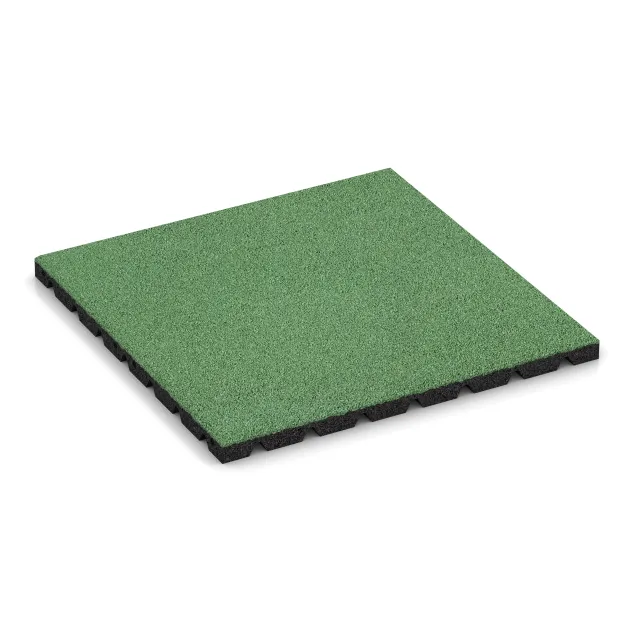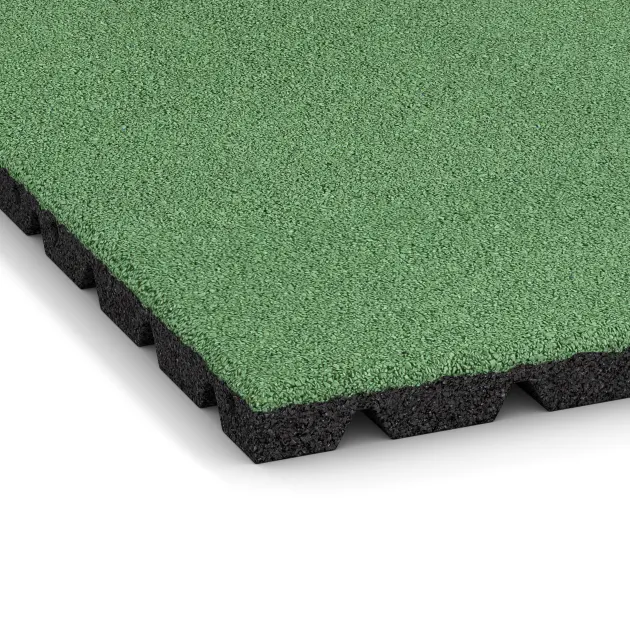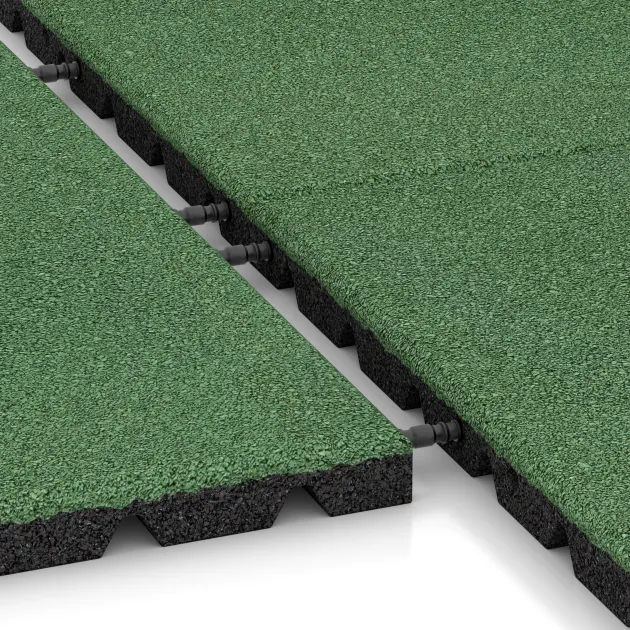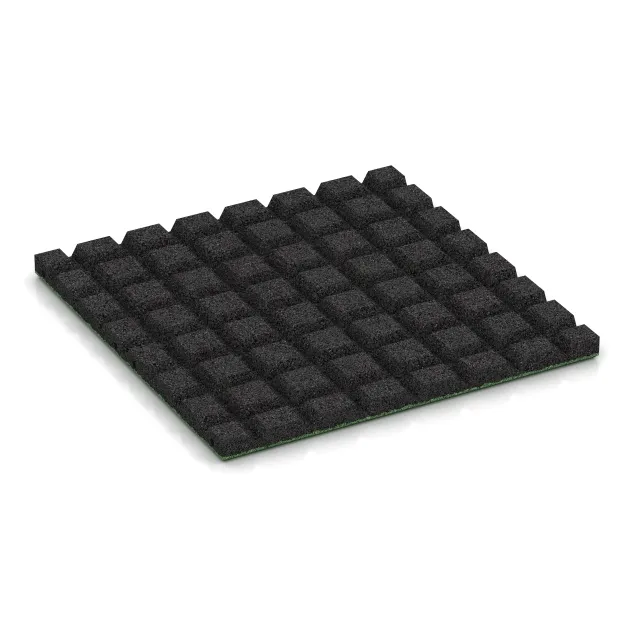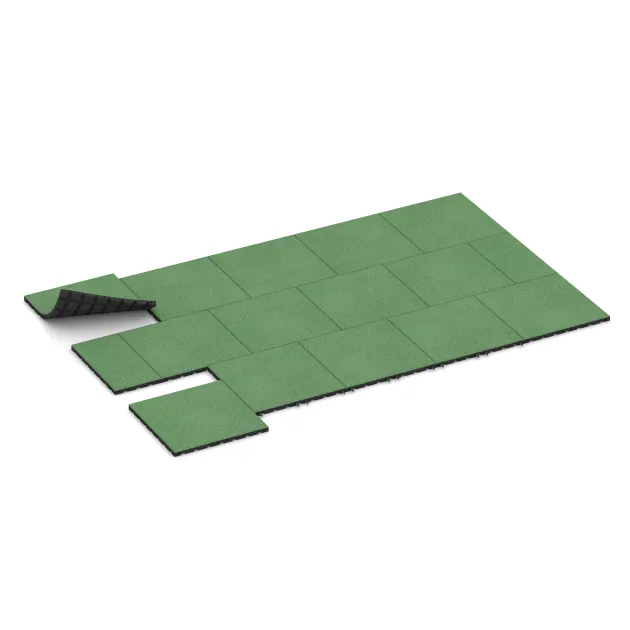Terrace tile 3 cm FS "Pale Green"
- /
-
Delivery in approx.
7-14 days - £69.20 / 4 Piece / m²
- (5.05 kg / Piece)
EAN: 4251469305595 | Item no.: 0559
The 3 cm terrace tile is a compact and versatile solution for balconies, roof terraces and smaller outdoor areas that require a stable and attractive surface. With its 40×40 cm format and 3 cm thickness, it is ideal for areas of up to around 35 m².
Half-bond with dowel system. The tiles are installed in a half-bond pattern. The supplied dowels connect the tiles securely across rows, ensuring permanent stability. The staggered installation creates a harmonious and solid layout. To maintain long-term positional stability, an edge restraint is required. In addition, spot-gluing the edge tiles can further increase overall stability.
Comfort & safety. The surface is slip-resistant and provides reliable footing in both dry and wet conditions. The elastic structure reduces impact and footstep noise, creating a comfortable and joint-friendly walking experience. Compared to stone or ceramic, the tiles are more comfortable and pleasant to walk on, even barefoot.
Low-maintenance & quick-drying. Rainwater drains through the porous structure so the surface dries quickly and remains free of puddles. Fine dirt is rinsed away naturally, while coarse dirt can easily be removed with a broom, hose or pressure washer. No regular maintenance such as sealing or sanding is required.
Weatherproof & durable. The 3 cm terrace tile is frost- and weather-resistant and designed for year-round use. Like all outdoor floor coverings, some natural ageing will occur, but compared to alternatives such as stone, ceramic or wood, these signs remain minimal and have little effect on performance.
With its practical format, dowel interlock system in half-bond installation and easy-care properties, the 3 cm terrace tile is a functional and visually appealing choice for small to medium-sized outdoor areas.
Discount
Product Highlights
Characteristics
Product Details – Material and Structure
Comparative values
To calculate how many tiles you need for your project, simply use the online installation planner available in the shop. This free browser-based tool is directly accessible on each product page – just below the price and quantity selection. Click on “Plan installation” to open the tool instantly – no registration or download required.
Enter the dimensions of your area, such as the length and width in metres. The planner will then automatically calculate the total number of tiles required, including a realistic allowance for offcuts. You’ll also be shown a suitable layout pattern for the selected product. The tool is user-friendly, accurate and ideal for planning your material requirements with confidence.
All WARCO tiles designed for outdoor use are permanently weather-resistant and highly durable. They do not rot, decay or develop mould, and they cannot come loose from the ground, as they are installed without adhesive. Even under frost or intense sunlight, the tiles do not crack or break.
As with wood and other materials, rubber granulate tiles can undergo slight dimensional changes. Due to temperature fluctuations or temporary moisture absorption, the material may expand or contract slightly – a natural effect.
Thanks to their open-pored structure, WARCO tiles are water-permeable. Rainwater can drain evenly through the tiles into the ground, preventing puddles from forming. The water either flows through the integrated drainage structure beneath the tiles or seeps naturally into the soil. This ensures that the surface remains usable even in wet conditions and dries quickly.
WARCO tiles also feature a slip-resistant surface that provides secure footing even when wet. No additional surface treatment is required, as the tiles are low-maintenance, long-lasting and perfectly suited for continuous outdoor use.
Yes, that is the standard approach. The vast majority of our customers – whether private, municipal, or commercial – install the delivered WARCO tiles themselves or with their own staff. The installation is simple and requires no special skills. Only fitting the curb into a concrete foundation with back support demands a little extra craftsmanship. Cutting the elements to size and laying them on a suitable substrate is not challenging. You can find all essential installation information in our Expert Advice – FAQ section on our website.
WARCO offers several connection systems for floor tiles, each differing in design, installation method and visual appearance. Below is an overview of the key differences:
Puzzle joint (visible)
In this system, the tile edges feature an interlocking profile reminiscent of classic jigsaw teeth or mushroom-shaped connectors. During installation, the profiles of adjacent tiles interlock to form a continuous connection across the full tile thickness.
The joint profile may be formed directly during pressing or precisely cut after the tile has cured. Whether the joint is visible in the finished surface depends on the edge finish (e.g. with or without chamfer) and the surface colouration.
The symmetrical shape ensures uniform load transfer and makes this type of joint the most mechanically stable option.
Plug-in connectors (plastic dowels)
This system uses separate connecting elements, typically round plastic dowels, which are inserted into pre-drilled holes along the sides of the tiles. The tiles themselves have smooth, straight edges similar to precast concrete slabs.
Installation is carried out in a half-bond (stretcher bond) pattern: each tile is connected via dowels to two tiles in the row above and two in the row below. This prevents lateral shifting, although some movement along the length of the dowels remains possible. For this reason, an edge restraint must be installed around the perimeter to stabilise the entire area.
Concealed puzzle joint
This method is based on the same mechanical principle as the classic puzzle joint, but is designed to be invisible in the finished surface. The interlocking profile is located on the underside of the tile, integrated into a rebated step joint.
Two tile edges feature a positive locking profile, the other two a matching negative profile. When laid, the tiles interlock securely from below, forming a durable mechanical connection. From above, the surface appears seamless and aligned, typically with a clean, square joint pattern similar to a chessboard layout.

